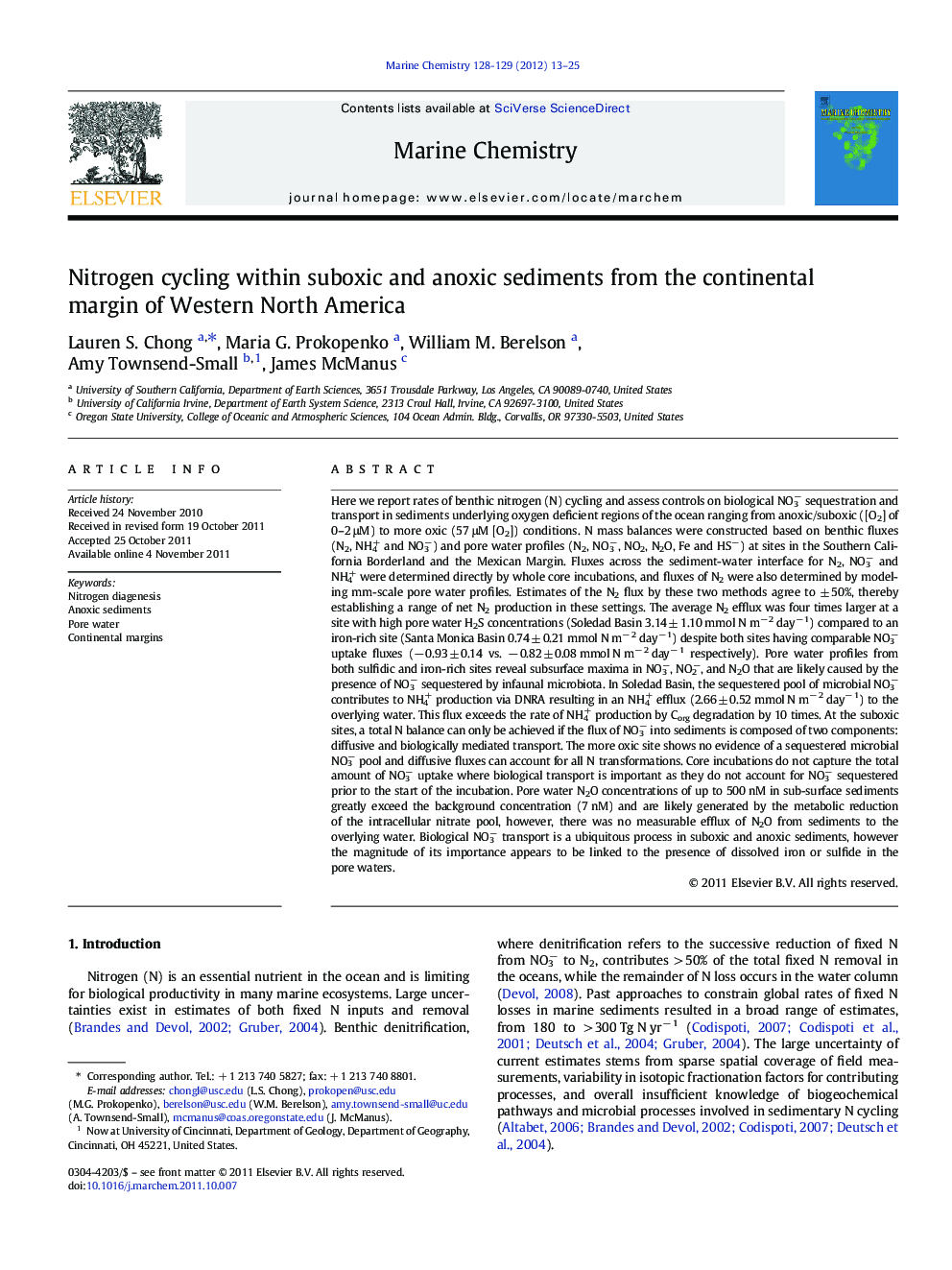| کد مقاله | کد نشریه | سال انتشار | مقاله انگلیسی | نسخه تمام متن |
|---|---|---|---|---|
| 1261861 | 1496696 | 2012 | 13 صفحه PDF | دانلود رایگان |

Here we report rates of benthic nitrogen (N) cycling and assess controls on biological NO3− sequestration and transport in sediments underlying oxygen deficient regions of the ocean ranging from anoxic/suboxic ([O2] of 0–2 μM) to more oxic (57 μM [O2]) conditions. N mass balances were constructed based on benthic fluxes (N2, NH4+ and NO3−) and pore water profiles (N2, NO3−, NO2, N2O, Fe and HS−) at sites in the Southern California Borderland and the Mexican Margin. Fluxes across the sediment-water interface for N2, NO3− and NH4+ were determined directly by whole core incubations, and fluxes of N2 were also determined by modeling mm-scale pore water profiles. Estimates of the N2 flux by these two methods agree to ± 50%, thereby establishing a range of net N2 production in these settings. The average N2 efflux was four times larger at a site with high pore water H2S concentrations (Soledad Basin 3.14 ± 1.10 mmol N m− 2 day− 1) compared to an iron-rich site (Santa Monica Basin 0.74 ± 0.21 mmol N m− 2 day− 1) despite both sites having comparable NO3− uptake fluxes (− 0.93 ± 0.14 vs. − 0.82 ± 0.08 mmol N m− 2 day− 1 respectively). Pore water profiles from both sulfidic and iron-rich sites reveal subsurface maxima in NO3−, NO2−, and N2O that are likely caused by the presence of NO3− sequestered by infaunal microbiota. In Soledad Basin, the sequestered pool of microbial NO3− contributes to NH4+ production via DNRA resulting in an NH4+ efflux (2.66 ± 0.52 mmol N m− 2 day− 1) to the overlying water. This flux exceeds the rate of NH4+ production by Corg degradation by 10 times. At the suboxic sites, a total N balance can only be achieved if the flux of NO3− into sediments is composed of two components: diffusive and biologically mediated transport. The more oxic site shows no evidence of a sequestered microbial NO3− pool and diffusive fluxes can account for all N transformations. Core incubations do not capture the total amount of NO3− uptake where biological transport is important as they do not account for NO3− sequestered prior to the start of the incubation. Pore water N2O concentrations of up to 500 nM in sub-surface sediments greatly exceed the background concentration (7 nM) and are likely generated by the metabolic reduction of the intracellular nitrate pool, however, there was no measurable efflux of N2O from sediments to the overlying water. Biological NO3− transport is a ubiquitous process in suboxic and anoxic sediments, however the magnitude of its importance appears to be linked to the presence of dissolved iron or sulfide in the pore waters.
► Porewater profiles in reducing sediments have maxima caused by biological storage and use of NO3−.
► The total NO3− flux into reducing sediments is the sum of diffusive and biological transport.
► NO3− storage and transport appears to be ubiquitous in reducing sediments.
► More N leaves sediments in sulfidic systems than combined NO3- and Corg burial fluxes can account for.
Journal: Marine Chemistry - Volumes 128–129, 20 January 2012, Pages 13–25